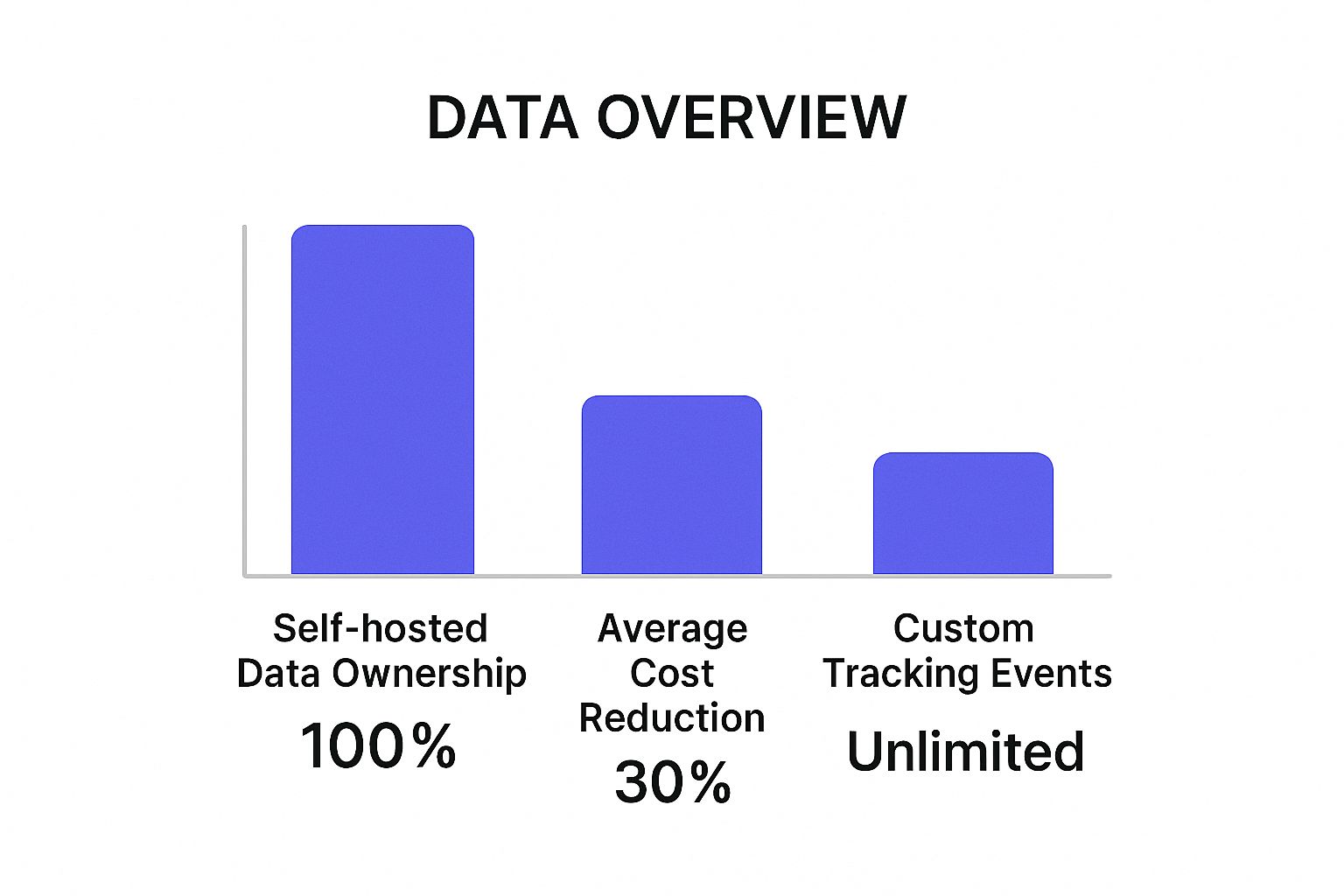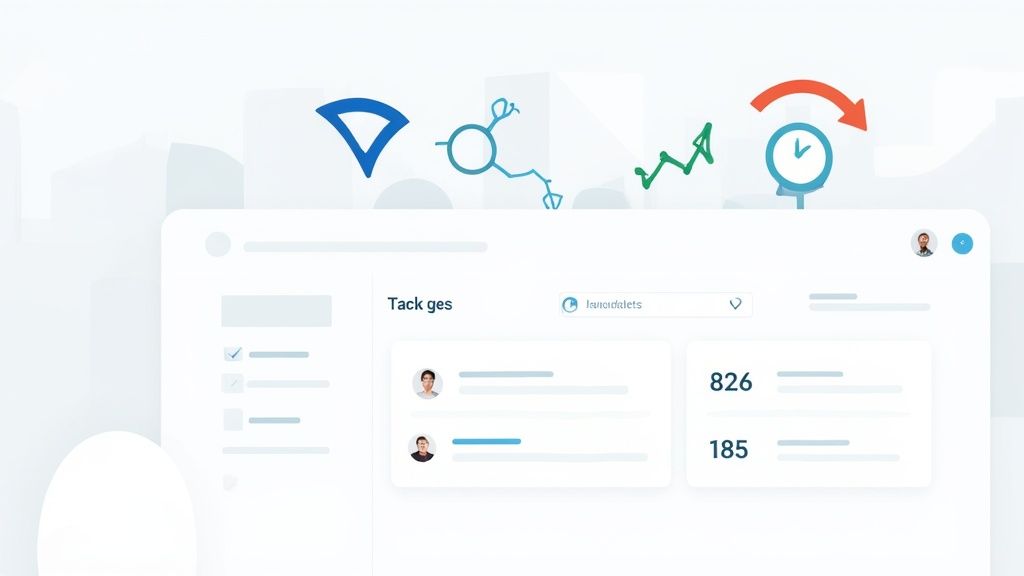- Date
Open Source Web Analytics: Free, Flexible, Privacy-Focused
 Andrii Romasiun
Andrii Romasiun
When you hear "web analytics," you probably think of the big, proprietary players. But there's another way—one that offers a transparent, customizable alternative and gives you full control and ownership over your website data.
With open source web analytics, you’re not sending your user information off to some third-party server in the cloud. Instead, you can host the analytics platform yourself, which is a game-changer for privacy and compliance.
What Is Open Source Web Analytics

Think of proprietary analytics platforms like a sealed, pre-made meal from a giant corporation. You get the final product, and it does the job, but you have no real idea what went on in the kitchen. You just have to trust that the ingredients are good and the process is clean. That "black box" approach is standard for most mainstream tools, where all your data is processed on their servers, completely hidden from your view.
Open source web analytics flips that model on its head. It’s like being handed the full recipe and given your own professional-grade kitchen. You can inspect every ingredient (the source code), control the entire cooking process (how data is collected and stored), and ultimately, you own the final dish (your website data). This transparency is what it's all about.
The Core Principles
At its heart, open source software is built on the idea of making its source code publicly available for anyone to view, modify, and share. When you apply this philosophy to web analytics, it solves a lot of the big challenges we face online today.
Here’s what makes it different:
- Transparency: The code is right there for you to audit. You can see exactly how data is tracked and processed, leaving no room for hidden algorithms or sneaky data-sharing practices.
- Control: You get to decide where your data lives. It can be on your own servers (self-hosted) or with a provider you trust. This is the cornerstone of achieving true data sovereignty.
- Flexibility: Need to track a specific user interaction that standard tools just don't cover? With open source, you or your developers can dive into the code and build custom tracking solutions that fit your business perfectly.
This approach puts you firmly in the driver's seat. Instead of just renting access to your own data, you become its sole owner and protector. This isn't just a small technical detail; it's a fundamental shift in how you manage your most valuable digital asset. To dig deeper, you can explore our guide on what is web analytics and its core concepts.
The fundamental promise of open source analytics is simple: Your data belongs to you. It eliminates the risk of your analytics provider using your user data for their own purposes, such as ad targeting or market research.
This model has emerged as a direct response to the growing unease over data privacy and the often-opaque practices of big tech. With regulations like GDPR getting stricter, businesses are actively looking for solutions that offer a clear and straightforward path to compliance. An open source tool provides exactly that, letting you build a data strategy based on trust and respect for your users.
Why Businesses Are Choosing Open Source Analytics
The move toward open source web analytics isn't just about saving a few bucks—it's a deliberate strategic shift. Companies are walking away from the big, proprietary names to get a better handle on their data, more flexibility, and a greater sense of trust. It all comes down to taking back control over one of their most valuable assets: customer data.
When you dig into why this is happening, you find four powerful reasons that make open source analytics such a compelling choice. Each one directly addresses a major headache that comes with using closed-off, "black box" tools.
Complete Data Ownership and Privacy
With most big-name analytics tools, you're essentially renting a view of your data. It gets shipped off to their servers, and they give you back dashboards and reports. You never truly own the raw information. Open source completely flips that script.
When you self-host your analytics, every byte of data your site collects stays on your servers. This seems like a small change, but the implications are huge. You are the sole owner of the data. No third party can peek at it, sell it, or use it to train their ad algorithms. That's a massive win for building trust with your audience.
This infographic breaks down some of the biggest advantages you gain by taking your analytics in-house.

As you can see, owning your data and tracking without limits are direct benefits of the open source model, which often leads to major cost savings down the road.
This level of control has become crucial in a world of complex privacy laws. Regulations like GDPR have changed the game, making tools that prioritize data sovereignty far more appealing. For example, a platform like Swetrix is built to be 100% GDPR compliant because the data never leaves your infrastructure. This is a non-negotiable for many businesses, especially those in the EU, and it's a key reason why server-side tagging and first-party data strategies are becoming standard practice. You can see more about how privacy is impacting analytics tool selection on swetrix.com.
Unmatched Customization
Off-the-shelf analytics tools are built for the masses. They give you a one-size-fits-all dashboard, which means you often can't track the specific, unique interactions that actually drive your business forward. Open source platforms, on the other hand, are designed to be taken apart and put back together.
With access to the source code, your analytics tool is no longer a rigid product but a flexible framework. You can adapt it to your exact needs.
Let's say you run a SaaS app and just launched a cool new feature. A standard tool might just tell you someone clicked a button. That's not very helpful. With an open source solution, you could create a custom event that captures rich context—like which part of the feature they used, for how long, and what they did next. That’s the kind of granular insight you just can't get from a locked-down platform.
Cost-Effectiveness and Predictability
While "open source" often brings "free" to mind, it's more helpful to think in terms of total cost of ownership. The software license is free, but you'll have some costs for hosting, whether on your own hardware or in the cloud.
Even so, this model delivers two huge financial advantages:
- No Per-User Licensing Fees: Need to add 5, 10, or 50 more people to your team? Go for it. Your bill won't suddenly jump.
- Predictable Scaling Costs: Your expenses are tied directly to server resources like CPU and storage. This is far more transparent and controllable than the mysterious, tiered pricing plans of most proprietary tools that seem designed to push you into a pricey enterprise contract.
For a growing business, the total cost of running a self-hosted analytics solution is often dramatically lower than what they'd pay for a big-name enterprise tool.
Transparency and Security
Trust is everything online. When you use a closed-source analytics tool, you're forced to take the company's word that they're handling your data securely and ethically. You can't actually look under the hood to verify anything. Open source throws the doors wide open.
Because the source code is public, anyone can inspect it—your developers, independent security researchers, or the entire global community. This "many eyes" approach means bugs and vulnerabilities get spotted and patched quickly. More importantly, you can review the code yourself to be absolutely sure there are no backdoors or shady data-sharing practices. That level of transparency builds a rock-solid foundation of trust that a black box system can never match.
Comparing the Top Open Source Analytics Platforms

Diving into the world of open source web analytics can feel a bit like walking into a massive library. Each platform tells a different story, follows a unique philosophy, and is built for a specific kind of reader. The right choice really comes down to what you need, how comfortable you are with the tech side of things, and how deep you need to go with your data.
So, instead of just running down a list of features, let's get to know the personalities of three of the biggest names in the space: Matomo, Plausible, and Swetrix. Once you understand their distinct approaches, you'll have a much clearer idea of which one is the perfect fit for your project.
Matomo: The Enterprise Powerhouse
If you're looking for a tool that can do it all, you'll want to look at Matomo. It's been around since 2007 (originally called Piwik), making it a veteran in this space. Over the years, it has grown into a massive suite of tools that many see as the go-to, self-hostable alternative to Google Analytics. Its real power is in its sheer depth.
Think of Matomo as a professional workshop stocked with every tool you could possibly need. You get the standard metrics like user visits and goal tracking, of course. But you can also add on advanced features like heatmaps, session recordings, and A/B testing, although some of these are paid extras. This makes it a fantastic option for large companies or data-heavy marketing teams who need that granular level of control.
The trade-off for all that power? The user interface can feel a bit dated, and self-hosting a high-traffic Matomo setup is no small task. It can be a real resource hog, often needing dedicated servers just to keep things running smoothly.
Plausible: The Minimalist Champion
On the complete opposite side, you have Plausible. It was designed from the ground up with one clear goal: deliver the most important web analytics in a simple, lightweight, and incredibly fast package. Plausible intentionally sidesteps the feature-packed approach of bigger platforms, focusing only on the core metrics you need. No clutter, no confusion.
Plausible is like a perfectly organized, minimalist desk—it has everything you need and absolutely nothing you don't. The dashboard is clean, intuitive, and loads in a snap. And its tracking script is tiny (under 1KB), meaning it won't slow down your website at all. That’s a huge win for both user experience and SEO.
Plausible is built for people who put speed and simplicity first. It’s perfect for bloggers, content creators, and small businesses who just want to understand their traffic without getting bogged down in complicated reports.
The main limitation here is its focus. Plausible isn't trying to be a deep product analytics tool. If you need to track complex user journeys inside an app, you'll likely find it a bit too basic.
Swetrix: The Modern All-Rounder
Swetrix carves out a space right in the middle, mixing the streamlined feel of modern analytics with a feature set that goes well beyond simple website stats. It’s built for growing startups, developers, and product teams who need a tool that's both easy to use and powerful enough to scale with them.
You can think of Swetrix as a modern, modular toolkit. It gives you all the essential web analytics you'd expect—top pages, referrers, and visitor locations—in a super clean interface. But it doesn't stop there. It also packs in features you usually only find in more complex tools, like error tracking, performance monitoring, and custom event tracking. This makes it a great fit if you need to understand both your marketing funnels and the health of your application.
From day one, Swetrix was built to be privacy-first and cookieless, making GDPR compliance easy. Its open source foundation and API also make it a favorite for developers who want to pull analytics data into their own custom workflows. To see how it compares to the biggest player in the game, check out our guide on alternatives to Google Analytics.
Open Source Analytics Platform Comparison
To help you see the differences at a glance, this table breaks down how these platforms stack up on the most important factors. Think of it as a cheat sheet to match the right tool to your goals.
| Feature | Matomo | Plausible | Swetrix |
|---|---|---|---|
| Ideal User | Enterprises, data-heavy marketers, and government agencies needing extensive features. | Bloggers, content creators, and small businesses seeking simplicity and speed. | Startups, developers, and product teams needing a balance of web and product analytics. |
| Core Strength | Comprehensive feature set that rivals enterprise-grade proprietary tools. | Extreme simplicity, speed, and a lightweight tracking script. | A versatile blend of privacy-first web analytics, performance monitoring, and error tracking. |
| User Interface | Functional but can appear dated and complex to new users. | Clean, minimalist, and exceptionally easy to navigate. | Modern, intuitive, and designed for a clear user experience. |
| Privacy Focus | Strong privacy controls and GDPR features, but requires configuration. | Cookieless and privacy-by-design, requiring no cookie banners. | Natively cookieless, with a strong emphasis on data minimization and GDPR compliance. |
| Advanced Features | Heatmaps, session replay, funnels, A/B testing (often as paid add-ons). | Limited to core web metrics, goal tracking, and basic funnels. | Custom events, error tracking, real-user performance monitoring, and API access. |
| Hosting Options | Self-hosted (On-Premise) and a managed Cloud version. | Self-hosted (Community Edition) and a popular managed Cloud version. | Self-hosted (Community Edition) and a fully-featured managed Cloud version. |
At the end of the day, the best open source web analytics platform is the one that fits your resources, goals, and technical comfort level. Matomo offers unparalleled depth, Plausible provides beautiful simplicity, and Swetrix strikes a powerful balance for modern businesses that refuse to compromise on privacy or performance.
What to Look For in a Modern Analytics Tool

It’s easy to get lost in a long list of features when you're shopping for an analytics tool, whether it's a big-name proprietary suite or an open source web analytics platform. To find something that actually helps your business grow, you need to cut through the noise and focus on what turns raw data into real, actionable insights.
A modern analytics tool isn't just a scoreboard for your website traffic; it's a diagnostic kit. It should help you understand why things are happening, not just tell you what happened. The right features let you ask specific, meaningful questions about your users and get clear answers to guide your next move.
Core Tracking and User Behavior Analysis
The bedrock of any solid analytics platform is its ability to capture and make sense of user actions. This goes way beyond simple visitor counts. It's about uncovering the story behind each click and mapping out the entire customer journey.
- Custom Event Tracking: This is your secret weapon for understanding how people really interact with your site. Think of it as setting up your own custom milestones. You can track button clicks, form submissions, video plays, or file downloads to measure what truly matters, like how many users are adopting a new feature you just launched.
- User Flow and Funnel Analysis: This feature paints a picture of the exact paths visitors take through your website. You can build out multi-step funnels—like a checkout process or a sign-up flow—and see precisely where people are getting stuck and leaving. Discovering a 70% drop-off between adding an item to the cart and starting checkout is the kind of powerful, money-making insight this analysis delivers.
An analytics tool without strong event tracking is like a map with no landmarks. You can see the terrain, but you have no idea if anyone is reaching the important destinations you’ve built.
These features are absolutely critical for finding and fixing friction points. Once you know where your conversion funnels are leaking, you can make targeted improvements to your site’s design and user experience that have a direct impact on your bottom line.
Reporting and Data Accessibility
Collecting data is only half the job. The real magic happens when you can get timely, understandable insights to the people who need them. A modern tool should prioritize speed and clarity, making sure your valuable data doesn't get buried in a complex report only a data scientist can love.
A clean, intuitive user interface is a must. If your marketing team can't figure it out, they won't use it, and all that data goes to waste. The main dashboard should present key metrics clearly, making it easy for anyone on the team to get a quick pulse on performance.
Beyond that, look for these two essential capabilities:
- Real-Time Reporting: The ability to see data as it comes in is a game-changer for fast-moving teams. When you launch a new ad campaign or a flash sale, you need to see what's happening now, not wait 24 hours for the numbers to update. Real-time data lets you make quick pivots to optimize your efforts on the fly.
- API Access: This is a non-negotiable for integrating analytics into your broader business intelligence stack. A good API allows you to pull your website data into other systems, like a CRM, a data warehouse, or a custom internal dashboard. This helps you create a single, unified view of your business and break down those frustrating data silos.
Ultimately, picking the right open source web analytics platform is about finding a tool that not only gathers accurate data but also serves it up in a way that empowers your entire team to act. The goal is to make data-driven decisions a natural part of your daily rhythm, and that all starts with features that provide clarity, not just more complexity.
How Swetrix Delivers Privacy Without Compromise
When you're wading through the world of open source web analytics, you quickly realize that a tool's philosophy matters just as much as its feature list. This is where Swetrix really shines. Its entire platform is built on one core belief: you can get deep, meaningful insights without ever having to sacrifice user privacy. It’s built for modern businesses that just aren't willing to make that trade-off between data and ethics.
It all starts with a surprisingly lightweight design. Unlike some of the older, clunkier platforms that can slow your site to a crawl, Swetrix was engineered from the ground up for speed. The tracking script is tiny, which means it has virtually zero impact on your page load times—something that’s critical for keeping both your users and Google happy.
The demand for tools like this is exploding. The global open-source market was valued at USD 34.4 billion in 2024 and is on track to hit USD 40 billion by 2025. This growth is all about a rising demand for transparent, flexible software, especially in analytics where privacy has become a major concern. You can read more about this huge market shift and what it means for platforms like Swetrix on electroiq.com.
A Cookieless Foundation
The heart of Swetrix's privacy-first model is its firm commitment to cookieless tracking. It completely avoids persistent cookies and other invasive methods used to track individual users. This lets you gather the data you need without building creepy, detailed profiles of your visitors.
This isn’t just some add-on feature; it’s a fundamental design choice. Because of it, complying with regulations like GDPR and CCPA becomes incredibly straightforward. Instead of trying to patch on privacy controls as an afterthought, Swetrix is compliant by its very nature. And the best part? No more annoying cookie banners. That means a cleaner, more trustworthy experience for everyone who lands on your site.
Swetrix is a great example of data minimization in action. It’s designed to collect only what's truly necessary for useful analytics, and it deliberately steers clear of harvesting any personally identifiable information (PII).
This disciplined approach ensures you get the metrics that matter—like top pages, referral sources, and user engagement—without ever crossing an ethical line.
Performance Meets Practical Insights
Don't mistake a privacy-first approach for a lack of power. Swetrix is living proof that you can absolutely have both. It delivers a rich, detailed view of user behavior while always respecting their data.
So, how does it pull off this balancing act?
- Actionable Metrics: You get all the essentials—bounce rates, session durations, real-time visitor counts—laid out in a dashboard that’s clean and easy to understand.
- Performance Monitoring: Swetrix goes beyond just traffic stats. It includes real-user monitoring (RUM), so you can see how your site is actually performing for real people and pinpoint any frustrating bottlenecks.
- Error Tracking: It’s also a huge help for developers. The platform automatically catches and groups frontend errors, giving you the context you need (like browser, device, and page) to squash bugs faster.
By bringing all these capabilities together, Swetrix gives you a complete, 360-degree view of your online presence. It’s a powerful tool for any business that wants to make smart, data-driven decisions while building a brand that people can actually trust.
Setting Up Your Own Analytics Platform
Taking the reins of your own data by self-hosting an open source web analytics platform sounds intimidating, right? Like something only a seasoned developer could pull off. But the reality is, it's more accessible today than ever before. You're not writing code from scratch; you're just following a clear path to create a private, secure home for your analytics.
The first step is simply getting a place for your platform to live online. This is usually a cloud server, which is basically a virtual computer you rent from a provider like DigitalOcean, Vultr, or Hetzner. These services offer affordable and flexible options that can easily scale as your website traffic grows, giving you a solid foundation for your setup.
The demand for this kind of data control is skyrocketing. The web analytics market is on track to hit USD 7.98 billion by 2025, largely because businesses need better insights to make smart decisions. While big proprietary tools have led the charge, open-source options are carving out a significant niche by offering the privacy and ownership that modern companies crave. You can discover more about web analytics market trends on mordorintelligence.com.
The Modern Installation Path
Once you’ve got your server ready, you'll find that installing modern open source tools is surprisingly simple. Gone are the days of wrestling with complex manual configurations. Today, most platforms are built to run with container technology like Docker.
Think of Docker like a standardized shipping container for software. The developers pack the entire analytics platform—and everything it needs to run—inside this container. All you have to do is run it on your server. This clever approach wipes out frustrating compatibility problems and makes setup a breeze.
What used to be a long, technical ordeal now boils down to running just a few commands in your terminal. For a great example of how this works in practice, you can read our guide on self-hosting Swetrix V3, which walks you through just how straightforward it can be.
The Best of Both Worlds: Managed Hosting
So, what if you want total data ownership without the responsibility of managing a server yourself? That's where managed hosting from an open source provider comes in, offering a perfect compromise.
It’s a simple but powerful arrangement:
- You Own the Data: Your analytics instance is yours and yours alone, completely isolated from anyone else.
- They Handle the Maintenance: The provider takes care of all the behind-the-scenes work, like server updates, security patches, and performance tweaks.
- You Get Full Control: You still enjoy all the flexibility, privacy, and power of an open source platform.
This "have your cake and eat it too" approach blends the core benefits of open source web analytics with the hands-off convenience of a managed service. It’s a fantastic choice for businesses of any size that want power without the hassle.
Got Questions? We've Got Answers
Stepping into the world of open source web analytics can bring up a few questions. It's a different way of thinking about your data, so it's natural to wonder about the costs, the learning curve, and what you can really get out of it. Let's clear up some of the most common queries.
"Free" Doesn't Mean Zero Cost, Does It?
You're right, it doesn't. While the software itself won't cost you a dime in licensing fees, you do have to run it somewhere. If you self-host, you'll have server costs and the time investment for setup and upkeep.
Many people opt for a managed cloud version from the provider. You pay a monthly fee, and they handle all the technical heavy lifting for you. The real financial win is ditching those massive enterprise license fees, not eliminating every single expense.
The true value isn't just about saving money. It's about freedom. You own the software and your data, which means no vendor lock-in and the flexibility to do what you want, when you want. That's a power proprietary tools can't give you.
How Painful Is It to Move Away from Google Analytics?
Technically? It's a piece of cake. You're just swapping one tracking snippet for another on your site. The real adjustment is getting used to a new dashboard and a different workflow.
You can't import your old data from Google Analytics, but many see this as a blessing in disguise. It's a chance for a clean slate—a perfect time to set up new, more meaningful goals with a privacy-first mindset. Plus, modern open source tools are built to be intuitive, making the transition much smoother than you might think.
Can Open Source Tools Really Compete on Features?
Absolutely. In fact, many mature platforms go toe-to-toe with the big proprietary names and often come out ahead in certain areas.
The secret weapon of open source web analytics is customizability. If you have a developer on your team, you can dive into the code, build your own plugins, and track hyper-specific metrics that are unique to your business. This allows you to mold your analytics into a tool that answers your specific questions, not just the generic ones.
Ready to see how simple and powerful privacy-first analytics can be? Explore Swetrix and start your free 14-day trial to get clear, actionable insights without compromise. Get Started with Swetrix.